Mutations in the thyroid transcription factor gene NKX2-1 result in decreased expression of SFTPB and SFTPC
- PMID: 29538355
- PMCID: PMC6599453
- DOI: 10.1038/pr.2018.30
Mutations in the thyroid transcription factor gene NKX2-1 result in decreased expression of SFTPB and SFTPC
Abstract
Background: Mutations in the NK2 homeobox 1 (NKX2-1) gene are associated with lung disease in infants and children. We hypothesize that disruption of normal surfactant gene expression with these mutations contributes to the respiratory phenotypes observed.
Methods: To assess transactivational activity, cotransfection of luciferase reporter vectors containing surfactant protein B or C (SFTPB or SFTPC) promoters with NKX2-1 plasmids was performed and luciferase activity was measured. To assess the binding of mutated proteins to target DNA, electrophoretic mobility shift assays (EMSA) were performed using nuclear protein labeled with oligonucleotide probes representing NKX2-1 consensus binding sequences followed by gel electrophoresis. The effect of overexpression of wild-type (WT) and mutant NKX2-1 on SFTPB and SFTPC was evaluated with quantitative real-time PCR.
Results: Decreased transactivation of the SFTPB promoter by both mutants and decreased transactivation of the SFTPC promoter by the L197P mutation was observed. EMSA demonstrated decreased DNA binding of both mutations to NKX2-1 consensus binding sequences. Transfection of A549 cells with NKX2-1 expression vectors demonstrated decreased stimulation of SFTPB and SFTPC expression by mutant proteins compared with that of WT.
Conclusion: Disruption of transcriptional activation of surfactant protein genes by these DNA-binding domain mutations is a plausible biological mechanism for disruption of surfactant function and subsequent respiratory distress.
Conflict of interest statement
Disclosure: The authors declare no conflict of interest.
Figures




References
-
- Lazzaro D, Price M, de Felice M, Di Lauro R. The transcription factor TTF-1 is expressed at the onset of thyroid and lung morphogenesis and in restricted regions of the foetal brain. Development 1991;113:1093–104. - PubMed
-
- Trueba SS, Auge J, Mattei G, et al. PAX8, TITF1, and FOXE1 gene expression patterns during human development: new insights into human thyroid development and thyroid dysgenesis-associated malformations. J Clin Endocrinol Metab 2005;90:455–62. - PubMed
-
- Guillot L, Carre A, Szinnai G, et al. NKX2–1 mutations leading to surfactant protein promoter dysregulation cause interstitial lung disease in “Brain-Lung-Thyroid Syndrome”. Hum Mutat 2010;31:E1146–62. - PubMed
-
- Hamdan H, Liu H, Li C, et al. Structure of the human Nkx2.1 gene. Biochim Biophys Acta 1998;1396:336–48. - PubMed
-
- Boggaram V Thyroid transcription factor-1 (TTF-1/Nkx2.1/TITF1) gene regulation in the lung. Clin Sci (Lond) 2009;116:27–35. - PubMed
Publication types
MeSH terms
Substances
Grants and funding
LinkOut - more resources
Full Text Sources
Other Literature Sources
Medical
Research Materials
Miscellaneous

